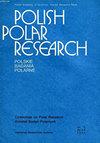乔治王岛南极峡湾固定式悬浮食饵的生长形态分类及其分布
IF 0.8
4区 地球科学
Q4 ECOLOGY
引用次数: 0
摘要
本文章由计算机程序翻译,如有差异,请以英文原文为准。
Growth form classification for sessile suspension feeders and their distribution in Antarctic fjord, King George Island
: Sessile suspension feeders depend primarily on availability of a space to settle and access to the water column. Their sessile nature incapacitates displacement during disturbances thus they rely on their morphology to overcome selective processes. We classified the assemblage of SSF from Mackellar Inlet (King George Island, Antarctica) according to their growth forms (GF) and epibiotic association type, the latter based on direct observation of the epibiotic behaviour of every individual. Organisms that did not comply with any previously established GF were grouped into ‘other GF’. Sampling stations were distributed across the fjord following a gradient based primarily on the distance to Domeyko Glacier (inner, middle, outer sections). Seven GF were recognised in the glaciomarine fjord: tree, bush, stalk, mound, flat, runner, and sheet. Four types of epibiotic associations were identified: basibiont, both facultative epibiont and basibiont, facultative epibiont (non-basibiont), and epibiont. Our results showed that the tree GF were found in the inner and middle sections, mound in middle and outer, and flat across all fjord sections. These GF enhanced GF-diversity since they constituted additional substrate for most of the ‘other GF’ which had primarily an epibiotic strategy. Contrastingly, bush, runner and stalk GF were only found in the outer section of the fjord, thus the most distanced from periglacial disturbances. The GF distribution was consistent with distance to glacier, both in number and strategies. These results highlight the potentialities of the morpho-functional classification applied to Antarctic sessile suspension feeders to help understand their distribution based on adaptive capabilities.
求助全文
通过发布文献求助,成功后即可免费获取论文全文。
去求助
来源期刊

Polish Polar Research
ECOLOGY-GEOSCIENCES, MULTIDISCIPLINARY
CiteScore
2.00
自引率
7.70%
发文量
0
审稿时长
>12 weeks
期刊介绍:
The quarterly Polish Polar Research edited by the Committee on Polar Research of the Polish Academy of Sciences is an international journal publishing original research articles presenting the results of studies carried out in polar regions.
All papers are peer-reviewed and published in English.
The Editorial Advisory Board includes renowned scientist from Poland and from abroad.
 求助内容:
求助内容: 应助结果提醒方式:
应助结果提醒方式:


